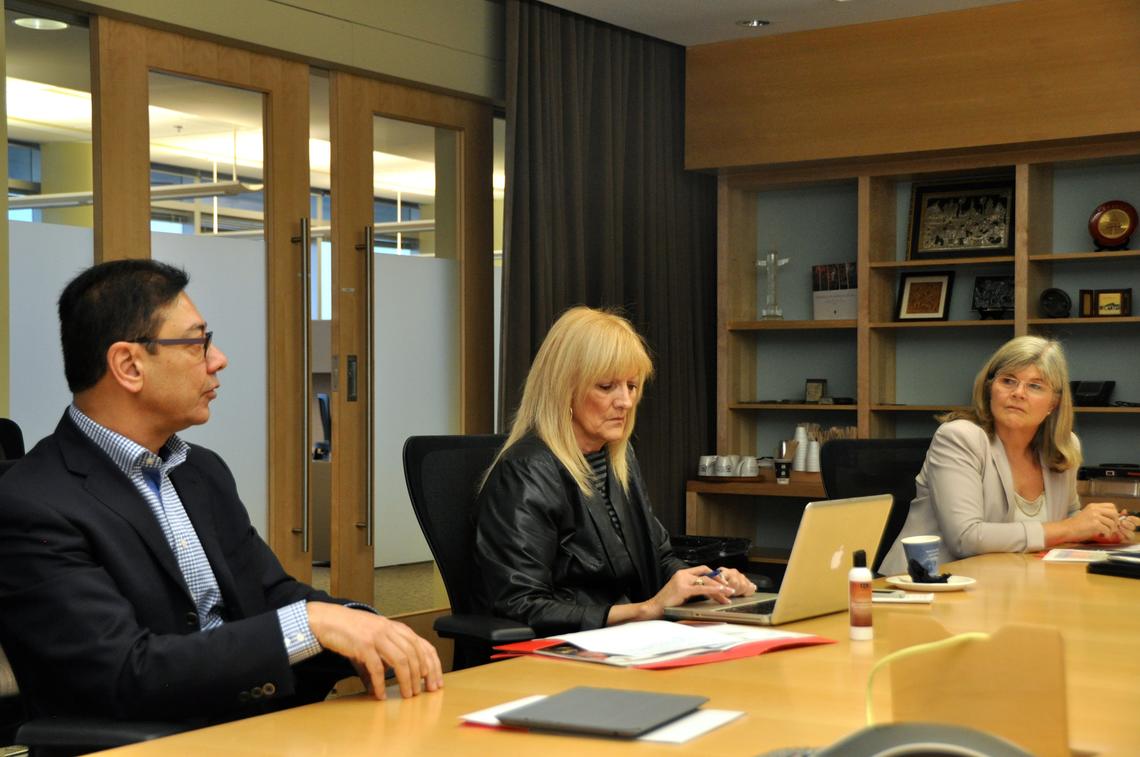
Council members, from right to left: Jennifer Hatfield, Colleen Kawalilak, and Kabir Javraj.
Feb. 26, 2014

The Tanzania Regional Advisory Council convened for its first working session recently to discuss the council’s objectives and scope, regional opportunities, and partnerships in the East African region and identify the strategic areas to focus on.
“Southeast Africa is changing fast and there’s a great opportunity to build capacity in research, medicine, energy and technology,” says Benedikt Hallgrimson, professor in the Department of Pathology and Laboratory Medicine, Faculty of Medicine, and chair of the Tanzania Regional Advisory Council.
Kabir Javraj, managing director for AgeCare Group of Companies, agrees. “East Africa's growth prospects over the next 20 years are very bright and they differ country by country and sector by sector. The possible sectors of opportunity range widely and include agriculture, banking, capital markets, consumer goods, infrastructure, mining, oil and gas and telecommunications, to name a few,” explains Javraj.
Pictured above are, from right to left: Benedikt Hallgrimsson, Anayancy Solis, Jennifer Hatfield, Colleen Kawalilak, Frank van der Meer, Sabrina Poonja, Shahirose Premji, Lashitew Gedamu, Lisa Allen, Kabir Javraj, and Janaka Ruwanpura.
Strategic focus on Tanzania
Tanzania is one of six countries of emphasis under the Eyes High International Strategy launched in 2013. The purpose of the new Tanzania council is to deepen our international ties and help shape the University of Calgary’s presence in the region (including Uganda, Burundi, Djibouti, and Ethiopia). Council participants reviewed the university’s presence and initiatives in the region and then focused on how our strengths in the areas of global health, energy, and smart city technologies could be leveraged to advance our international objectives.
Tanzania is a country of natural beauty and high adrenaline tourist attractions, from the high Kilimanjaro mountains, to Africa’s best wildlife safaris, to the breathtaking Island of Zanzibar where Freddie Mercury was born. Its population of 48 million is made up of more than 120 ethnic groups such as the Bantu Sukuma, Haya, Nyakyusa, and the nomadic Masaai people.
Unlike other African countries, Tanzania has enjoyed stability and annual economic growth of about seven per cent, mainly due to its rich natural resources such as gold, platinum, natural gas, and diamonds. Yet, Tanzania is still a developing country that struggles to fulfill the basic needs of its population for food, clean water, energy, health services, and jobs. The life expectancy numbers tell the story: on average, a Tanzanian will live 58 years while a Canadian will live 81 years.

Council members, from right to left: Jennifer Hatfield, Colleen Kawalilak, and Kabir Javraj.
A history of involvement
It is this array of opportunities that attracted the University of Calgary to be active in Tanzania for many years. A pattern of partnership in Tanzania and neighbouring countries includes strong integration of educational and research programs as well as field school experiences. University of Calgary students lucky enough to go there find the experience life-changing.
The Faculty of Medicine has rolled out several projects in Tanzania such as the development of the Master in Public Health program in collaboration with the Catholic University of Health and Allied Sciences in Bugando; continued health research in the Endulen hospital targeting the nomad Masaai population; and the East Africa Family Medicine Initiative.
In addition, the strong ties between Alberta and the Aga Khan development network create attractive prospects to build on our work in Tanzania for the mutual benefit of the University of Calgary and our institutional partners there.
Members of the Tanzania Regional Advisory Council